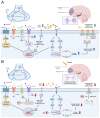Phytochemicals That Act on Synaptic Plasticity as Potential Prophylaxis against Stress-Induced Depressive Disorder
- PMID: 36694423
- PMCID: PMC9970837
- DOI: 10.4062/biomolther.2022.116
Phytochemicals That Act on Synaptic Plasticity as Potential Prophylaxis against Stress-Induced Depressive Disorder
Abstract
Depression is a neuropsychiatric disorder associated with persistent stress and disruption of neuronal function. Persistent stress causes neuronal atrophy, including loss of synapses and reduced size of the hippocampus and prefrontal cortex. These alterations are associated with neural dysfunction, including mood disturbances, cognitive impairment, and behavioral changes. Synaptic plasticity is the fundamental function of neural networks in response to various stimuli and acts by reorganizing neuronal structure, function, and connections from the molecular to the behavioral level. In this review, we describe the alterations in synaptic plasticity as underlying pathological mechanisms for depression in animal models and humans. We further elaborate on the significance of phytochemicals as bioactive agents that can positively modulate stress-induced, aberrant synaptic activity. Bioactive agents, including flavonoids, terpenes, saponins, and lignans, have been reported to upregulate brain-derived neurotrophic factor expression and release, suppress neuronal loss, and activate the relevant signaling pathways, including TrkB, ERK, Akt, and mTOR pathways, resulting in increased spine maturation and synaptic numbers in the neuronal cells and in the brains of stressed animals. In clinical trials, phytochemical usage is regarded as safe and well-tolerated for suppressing stress-related parameters in patients with depression. Thus, intake of phytochemicals with safe and active effects on synaptic plasticity may be a strategy for preventing neuronal damage and alleviating depression in a stressful life.
Keywords: Depression; Phytochemicals; Preventive agents; Stress; Synaptic plasticity.
Conflict of interest statement
The authors declare no conflict of interest.
Figures


Similar articles
-
Remodeling of axo-spinous synapses in the pathophysiology and treatment of depression.Neuroscience. 2013 Oct 22;251:33-50. doi: 10.1016/j.neuroscience.2012.09.057. Epub 2012 Oct 2. Neuroscience. 2013. PMID: 23036622 Free PMC article. Review.
-
Phytochemicals encouraging neurotrophic pathways: brain-derived neurotrophic factors as molecular targets in depression.Naunyn Schmiedebergs Arch Pharmacol. 2025 Jun 9. doi: 10.1007/s00210-025-04298-2. Online ahead of print. Naunyn Schmiedebergs Arch Pharmacol. 2025. PMID: 40490523 Review.
-
Antidepressant-like effect of ginsenoside Rb1 on potentiating synaptic plasticity via the miR-134-mediated BDNF signaling pathway in a mouse model of chronic stress-induced depression.J Ginseng Res. 2022 May;46(3):376-386. doi: 10.1016/j.jgr.2021.03.005. Epub 2021 Mar 20. J Ginseng Res. 2022. PMID: 35600767 Free PMC article.
-
The enriched environment ameliorates chronic unpredictable mild stress-induced depressive-like behaviors and cognitive impairment by activating the SIRT1/miR-134 signaling pathway in hippocampus.J Affect Disord. 2019 Apr 1;248:81-90. doi: 10.1016/j.jad.2019.01.031. Epub 2019 Jan 28. J Affect Disord. 2019. PMID: 30716615
-
Synaptic plasticity in depression: molecular, cellular and functional correlates.Prog Neuropsychopharmacol Biol Psychiatry. 2013 Jun 3;43:168-84. doi: 10.1016/j.pnpbp.2012.12.012. Epub 2012 Dec 23. Prog Neuropsychopharmacol Biol Psychiatry. 2013. PMID: 23268191 Review.
Cited by
-
Global trends of purinergic receptors and depression: A bibliometric analysis from 2003 to 2023.World J Psychiatry. 2025 Feb 19;15(2):102344. doi: 10.5498/wjp.v15.i2.102344. eCollection 2025 Feb 19. World J Psychiatry. 2025. PMID: 39974485 Free PMC article.
-
The influence of stress on mental health among Chinese college students: The moderating role of psychological suzhi.Heliyon. 2024 Feb 23;10(5):e26699. doi: 10.1016/j.heliyon.2024.e26699. eCollection 2024 Mar 15. Heliyon. 2024. PMID: 38444499 Free PMC article.
-
Exploring the transformative impact of traditional Chinese medicine on depression: Insights from animal models.World J Psychiatry. 2024 May 19;14(5):607-623. doi: 10.5498/wjp.v14.i5.607. eCollection 2024 May 19. World J Psychiatry. 2024. PMID: 38808079 Free PMC article. Review.
-
Phytochemicals in the treatment of patients with depression: a systemic review.Front Psychiatry. 2024 Dec 9;15:1509109. doi: 10.3389/fpsyt.2024.1509109. eCollection 2024. Front Psychiatry. 2024. PMID: 39717381 Free PMC article.
-
Ameliorating Effect of Fermented Perilla frutescens on Sleep Deprivation-Induced Cognitive Impairment Through Antioxidant and BDNF Signaling in Mice.Nutrients. 2024 Dec 6;16(23):4224. doi: 10.3390/nu16234224. Nutrients. 2024. PMID: 39683616 Free PMC article.
References
-
- Anjomshoa M., Boroujeni S. N., Ghasemi S., Lorigooini Z., Amiri A., Balali-Dehkordi S., Amini-Khoei H. Rutin via increase in the CA3 diameter of the hippocampus exerted antidepressant-like effect in mouse model of maternal separation stress: possible involvement of NMDA receptors. Behav. Neurol. 2020;2020:4813616. doi: 10.1155/2020/4813616. - DOI - PMC - PubMed
-
- Bergami M., Rimondini R., Santi S., Blum R., Gotz M., Canossa M. Deletion of TrkB in adult progenitors alters newborn neuron integration into hippocampal circuits and increases anxiety-like behavior. Proc. Natl. Acad. Sci. U. S. A. 2008;105:15570–15575. doi: 10.1073/pnas.0803702105. - DOI - PMC - PubMed
-
- Bergman J., Miodownik C., Bersudsky Y., Sokolik S., Lerner P. P., Kreinin A., Polakiewicz J., Lerner V. Curcumin as an add-on to antidepressive treatment: a randomized, double-blind, placebo-controlled, pilot clinical study. Clin. Neuropharmacol. 2013;36:73–77. doi: 10.1097/WNF.0b013e31828ef969. - DOI - PubMed
Publication types
LinkOut - more resources
Full Text Sources
Miscellaneous

